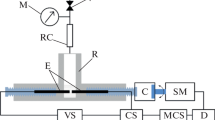Abstract
Investigation of the effects of pre-pressurization temperature on the high-pressure inactivation for single strains of aichivirus (AiV), coxsackievirus A9 (CAV9) and B5 (CBV5) viruses, as well as human parechovirus-1 (HPeV) was performed. For CAV9, an average 1.99 log10 greater inactivation was observed at 4 °C after a 400-MPa–5-min treatments compared to 20 °C treatments. For CBV5, an average of 2.54 log10 greater inactivation was noted after 600-MPa–10-min treatments at 4 °C in comparison to 20 °C treatments. In contrast, inactivation was reduced by an average of 1.59 log10 at 4 °C for HPeV. AiV was resistant to pressure treatments of 600 MPa for as long as 15 min at 4, 20, and 30 °C temperatures. Thus, different pre-pressurization temperatures result in different inactivation effects for picornaviruses.

Similar content being viewed by others
References
Calci, K. R., Meade, G. K., Tetzloff, R. C., & Kingsley, D. H. (2005). High pressure inactivation of hepatitis A virus within oysters. Applied and Environmental Microbiology, 71, 339–343.
Chen, H., Hoover, D. G., & Kingsley, D. H. (2005). Temperature and treatment time influence high hydrostatic pressure inactivation of feline calicivirus, a norovirus surrogate. Journal of Food Protection, 68, 2389–2394.
Kingsley, D. H. (2013). High pressure processing and its application to the challenge of virus-contaminated foods. Food and Environmental Virology, 5, 1–12.
Kingsley, D. H., Calci, K. R., Holliman, S., Dancho, B. A., & Flick, G. J. (2009). High pressure inactivation of HAV within oysters: Comparison of whole-in-shell with shucked oyster meats. Food and Environmental Virology, 1, 137–140.
Kingsley, D. H., & Chen, H. (2009). Influence of pH, salt, and temperature on pressure inactivation of hepatitis A virus. International Journal of Microbiology, 130, 61–64.
Kingsley, D. H., Chen, H., & Hoover, D. G. (2004). Inactivation of selected picornaviruses by high hydrostatic pressure. Virus Research, 102, 221–224.
Kingsley, D. H., Guan, D., & Hoover, D. G. (2005). Pressure inactivation of hepatitis A virus in strawberry puree and sliced green onions. Journal of Food Protection, 68, 1748–1751.
Kingsley, D. H., Guan, D., Hoover, D. G., & Chen, H. (2006). Inactivation of hepatitis A virus by high pressure processing: The role of temperature and pressure oscillation. Journal of Food Protection, 69, 2454–2459.
Kingsley, D. H., Holliman, D. R., Calci, K. R., Chen, H., & Flick, G. J. (2007). Inactivation of a norovirus by high pressure processing. Applied and Environmental Microbiology, 73, 581–585.
Kingsley, D. H., Hoover, D. G., Papafragkou, E., & Richards, G. P. (2002). Inactivation of hepatitis A virus and a calicivirus by high hydrostatic pressure. Journal of Food Protection, 65, 1605–1609.
Leon, J. S., Kingsley, D. H., Montes, J. S., Richards, G. P., Lyon, G. M., Abdulhafid, G. M., et al. (2011). Randomized, double-blinded clinical trial for human norovirus inactivation in oysters by high hydrostatic pressure processing. Applied and Environmental Microbiology, 77, 5476–5482.
Li, X., Ye, M., Neetoo, H., Golovan, S., & Chen, H. (2013). Pressure inactivation of Tulane virus, a candidate surrogate for human norovirus and its potential application in food industry. International Journal of Food Microbiology, 162, 37–42.
Lou, F., Neetoo, H., Chen, H., & Li, J. (2011). Inactivation of a human norovirus surrogate by high-pressure processing: effectiveness, mechanism, and potential application in the fresh produce industry. Applied and Environmental Microbiology, 77, 1862–1871.
Provost, K., Dancho, B. A., Ozbay, G., Anderson, R., Richards, G. P., & Kingsley, D. H. (2011). Hemocytes are sites of persistence for enteric viruses within oysters. Applied and Environmental Microbiology, 77, 8360–8369.
Reed, L. J., & Muench, H. A. (1938). A simple method of estimating fifty percent endpoints. American Journal of Hygiene, 27, 493–497.
Terio, V., Tantillo, G., Martella, V., Di Pinto, P., Buonavoglia, C., & Kingsley, D. H. (2010). High pressure inactivation of HAV within mussels. Food and Environmental Virology, 2, 83–88.
Wilkinson, N., Kurdziel, A. S., Langton, S., Needs, E., & Cook, N. (2001). Resistance of poliovirus to inactivation by high hydrostatic pressure. Innovative Food Science and Emerging Technologies, 2, 95–98.
Author information
Authors and Affiliations
Corresponding author
Additional information
US Department of Agriculture is an equal opportunity provider and employer. Mention of trade names or commercial products is solely for the purpose of providing specific information and does not imply recommendation or endorsement by the US Department of Agriculture.
Rights and permissions
About this article
Cite this article
Kingsley, D.H., Li, X. & Chen, H. Temperature Effects for High-Pressure Processing of Picornaviruses. Food Environ Virol 6, 58–61 (2014). https://doi.org/10.1007/s12560-013-9131-3
Received:
Accepted:
Published:
Issue Date:
DOI: https://doi.org/10.1007/s12560-013-9131-3




